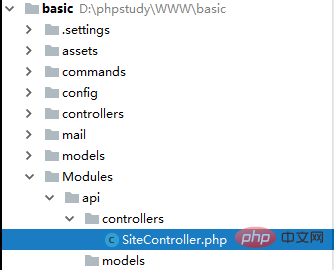Heim >PHP-Framework >YII >Wie greift das Yii-Framework auf den Controller unter dem benutzerdefinierten Modul zu?
Wie greift das Yii-Framework auf den Controller unter dem benutzerdefinierten Modul zu?
- 王林Original
- 2020-02-26 14:42:272656Durchsuche

Frage:
Wie greife ich auf die Aktionen im Site-Controller zu? Wie im Bild gezeigt:

Lösung:
1 Erstellen Sie ein Verzeichnis
Erstellen Sie zunächst die Verzeichnisstruktur wie oben und die Verzeichnis unter der API Es gibt drei Ordner und eine Datei Module.php. Der Inhalt dieser PHP-Datei lautet wie folgt:
<?php
namespace app\modules\api;
/**
* api module definition class
*/
class Module extends \yii\base\Module
{
/**
* @inheritdoc
*/
public $controllerNamespace = 'app\modules\api\controllers';
/**
* @inheritdoc
*/
public function init()
{
parent::init();
// custom initialization code goes here
}
}(Empfohlenes Tutorial: yii-Framework)
2. web.php
Erinnern Sie sich daran, dass sich im Konfigurationsordner im Stammverzeichnis des Projekts die folgenden Felder befinden:
<?php
$params = require __DIR__ . '/params.php';
$db = require __DIR__ . '/db.php';
$config = [
'id' => 'basic',
'basePath' => dirname(__DIR__),
'bootstrap' => ['log'],
'aliases' => [
'@bower' => '@vendor/bower-asset',
'@npm' => '@vendor/npm-asset',
],
'components' => [
'request' => [
// !!! insert a secret key in the following (if it is empty) - this is required by cookie validation
'cookieValidationKey' => 'jjsYJ_ju0W8ifOv5mY3JBMI6DOppFlo6',
],
'cache' => [
'class' => 'yii\caching\FileCache',
],
'user' => [
'identityClass' => 'app\models\User',
'enableAutoLogin' => true,
],
'errorHandler' => [
'errorAction' => 'site/error',
],
'mailer' => [
'class' => 'yii\swiftmailer\Mailer',
// send all mails to a file by default. You have to set
// 'useFileTransport' to false and configure a transport
// for the mailer to send real emails.
'useFileTransport' => true,
],
'log' => [
'traceLevel' => YII_DEBUG ? 3 : 0,
'targets' => [
[
'class' => 'yii\log\FileTarget',
'levels' => ['error', 'warning'],
],
],
],
'db' => $db,
/*
'urlManager' => [
'enablePrettyUrl' => true,
'showScriptName' => false,
'rules' => [
],
],
*/
],
'modules' => [
'api' => [
'class' => 'app\modules\api\Module',
],
],
'params' => $params,
];
if (YII_ENV_DEV) {
// configuration adjustments for 'dev' environment
$config['bootstrap'][] = 'debug';
$config['modules']['debug'] = [
'class' => 'yii\debug\Module',
// uncomment the following to add your IP if you are not connecting from localhost.
//'allowedIPs' => ['127.0.0.1', '::1'],
];
$config['bootstrap'][] = 'gii';
$config['modules']['gii'] = [
'class' => 'yii\gii\Module',
// uncomment the following to add your IP if you are not connecting from localhost.
//'allowedIPs' => ['127.0.0.1', '::1'],
];
}
return $config;3 API-Komponente
Jetzt sind wir in Erstellen einer neuen SiteControllers.php unter Modules/api/controllers, mit folgendem Inhalt:
<?php
namespace app\modules\api\controllers;
use yii\web\Controller;
class SiteController extends Controller
{
public function actionIndex()
{
echo "hello world";
}
}4. Browser-Zugriff
Schließlich die Der Browser greift auf diesen ActionIndex zu und gibt Folgendes ein: http:// localhost/basic/web/index.php?r=api/site/index

Fertig!
Weitere Inhalte zum Thema Programmierung finden Sie in der Spalte Einführung in die Programmierung auf der chinesischen PHP-Website!
Das obige ist der detaillierte Inhalt vonWie greift das Yii-Framework auf den Controller unter dem benutzerdefinierten Modul zu?. Für weitere Informationen folgen Sie bitte anderen verwandten Artikeln auf der PHP chinesischen Website!

